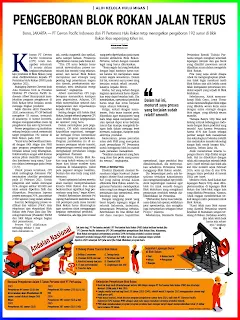PT Chevron Pacific Indonesia and PT Pertamina Hulu Rokan (PHR) continue to target drilling 192 wells in Block Rokan Riau this year.
In particular, PT Chevron Pacific Indonesia (CPI) has drilled 55 wells in the production rate containment activities in the Rokan Block which will be transferred to PT Pertamina Hulu Rokan (PHR) in August 2021.
Managing Director of Chevron Indo Asia Business Unit & President Director of PT Chevron Pacific Indonesia Albert Simanjuntak explained that the drilling program in the Rokan Block is continuing to maintain production levels.
Since starting at the end of December 2020, according to him, PT CPI has successfully drilled 55 wells, including 11 conversion wells, by operating six drilling rigs and one conversion rig.
The process of procuring additional rigs is underway to meet the target of drilling 192 wells in the Rokan Block by 2021.
Blogger Agus Purnomo in SKK Migas
"We continue to coordinate intensively with SKK Migas and PHR so that the drilling program can run as expected. The collaboration is very solid because all parties have the same passion and commitment, ”he said in a statement on Monday (17/5).
For the termination process, CPI has completed the PSC provisional checklist termination document on February 25, 2021. It has reached 81% for asset reporting, with approximately 109,000 assets that have been physically inspected and reported. The closure of project reports reached 70% or around 2,940 reports that have been completed.
Currently, the process of verification and validation (V&V) of exploration and exploitation data of the Rokan Block is underway by the Center for Data and Information Technology (Pusdatin) ESDM and SKK Migas as part of monitoring.
The V&V process was carried out on approximately 1 million items of printed documents, magnetic and optical media, and rock samples. The process is expected to be completed this month.
“The CPI team continues to work hard to realize a safe, reliable, and smooth termination and transition process. The Rokan block is a strategic asset that is important for state and regional revenues, the community's economy, and national energy security, "he said.
Albert said the CPI is also trying to ensure the readiness of its employees. Meanwhile, CPI has submitted all personnel and organizational data to SKK Migas.
the Rokan Block Along with the transfer of management of the Rokan Block, almost all CPI employees will change their employment status to the new operator.
In preparing its employees, CPI has prepared organizational capabilities, held various communication forums and debriefing programs. The provisioning program includes technical preparation for transitions, positive mental development in facing change to financial management.
According to him, the Rokan Block's solid performance so far cannot be separated from the human resource factor behind it, namely employees with built-in expertise, culture, and work ethic.
"We are optimistic that they will be able to maintain the performance of the Rokan Block and can contribute significantly to new companies," said Albert.
Reforminer Institute founder Pri Agung Rakhmanto asked that all preparations for the transition period of the Rokan Block must be matured so that later it does not interfere with production operations.
At least, three crucial points need to be considered during the transition period for managing the Rokan Block. First, related to legal issues that must be resolved.
"Of course everything related to the legal basis must be completed because this is the basis for everything. In this regard, I think the process is relatively smooth, ”he told Bisnis.
Second, things related to operational activities must be ensured that they continue to run well. He explained that production operations must continue and continue without any vacancies.
Third, related to management. During the transition period, it is necessary to ensure that the new management can ensure that operations can continue to run smoothly and can manage properly in maintaining the level of investment, reserves, and ultimately production.
According to him, finding partners by PHR, a subsidiary of PT Pertamina to work on the block, is a management problem.
"Later the new management will and need to assess all of it," he said.
NEED TO PARTNER
Executive Director of the National Oil and Gas Companies Association (Aspermigas) Moshe Rizal explained that the most crucial thing in managing the Rokan Block is how Pertamina gets a strong partner with strong funding and operational capabilities, as well as strong technology.
With great responsibility to oil and gas fields throughout Indonesia, he added, Pertamina's capacity is limited. This limitation can be seen in terms of funds and operational capabilities. To maximize production, he suggested that Pertamina should not work on the Rokan Block itself.
He argues that there needs to be aware of its capacity and put aside political egos in the national interest so that the block is not in the same boat as the Mahakam Block, which has experienced a decline in production after being transferred to Pertamina.
"Must be willing to cooperate in terms of operations, at least joint operatorship, and perhaps also offer most of the PI," he explained.
Basuki Tjahaja Purnama AKA Ahok
Previously, Pertamina President Commissioner Basuki Tjahaja Purnama was reviewing several oil and gas fields owned by the company to be used as a reference in managing the Rokan Block.
The man who is familiarly called Ahok revealed that his party did not want to make the Rokan Block's fate when it was transferred to management, not to experience a decline in production as happened in the Mahakam Block.
The Cepu Block Exxonmobil
Previously, Ahok visited Cepu Block, East Java to compare oil and gas blocks managed in collaboration with strategic partners with oil and gas blocks that are managed independently.
"Why can Banyu Urip become the pride of Indonesia's oil field with low production costs? Is it because Pertamina is only 45% and Exxon as a partner has excellent management and technology? They train and transfer technology very well for our nation, ”he said recently.
Ahok said that Banyu Urip's field performance was considered very good. This is evidenced by the absence of oil spills of more than 1 barrel of oil and no lost time incidents since February 2016, and uptime of over 99% with production costs below the US $ 2 per barrel.
According to Ahok, the results of the study from the Banyu Urip field will be implemented in the Rokan Block field and other oil and gas blocks managed by Pertamina. However, Ahok was reluctant to reveal the potential partners for the Rokan Block.
"We do not want the Wells blocks taken by Pertamina, such as the incident in Mahakam, not to be repeated in Rokan. Do it yourself, if not better, there must be a solution, "he said.
Bisnis Indonesia, page-4, Tuesday, May 18, 2021




















































